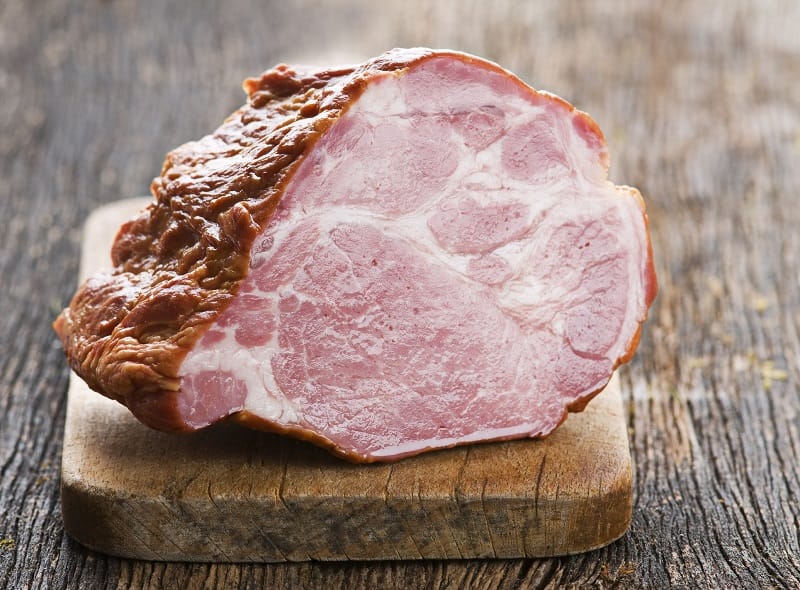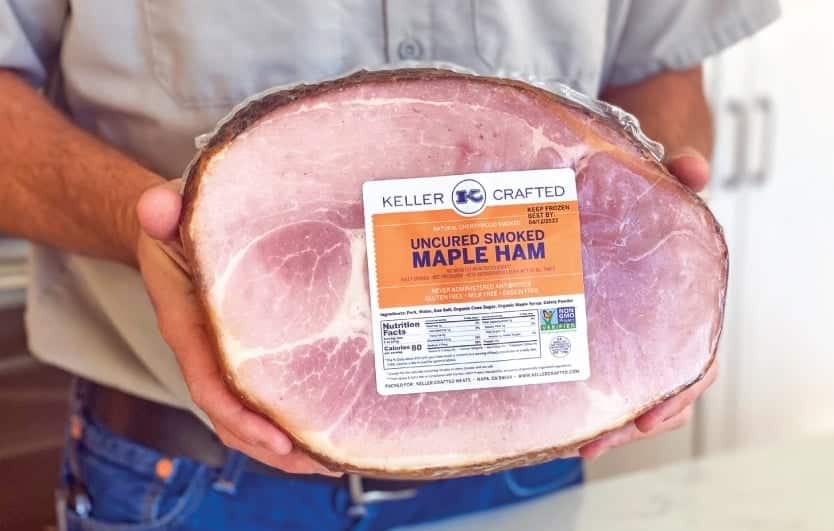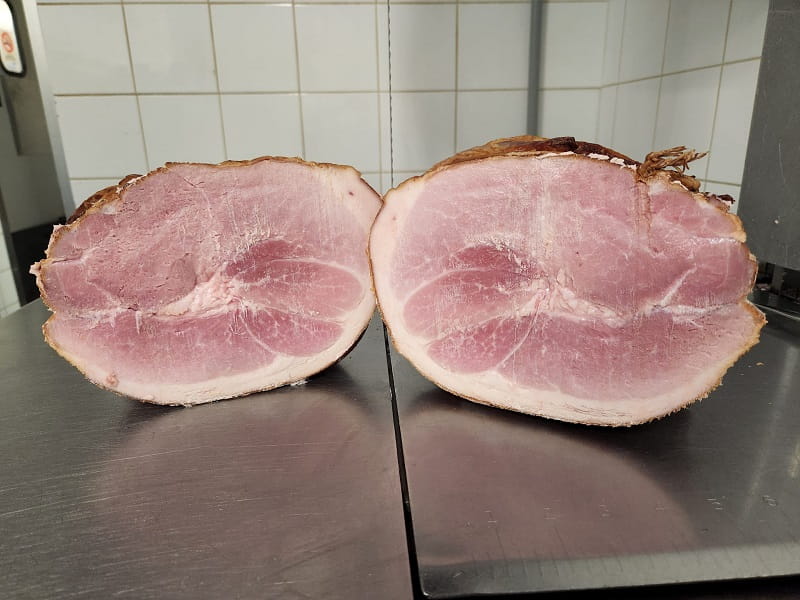The world of ham offers an enticing array of choices for discerning palates, with cured and uncured alternatives that have their unique characteristics and flavors. If you’ve found yourself in the grocery aisle, trying to decide between cured vs uncured ham for a special meal, you might have wondered what sets them apart and what the differences in taste, texture, and preparation techniques are.
Understanding these distinctions will expand your culinary knowledge and help you make more informed decisions when planning your next gathering or meal. Join us as we explore and unwrap the savory debate between cured and uncured ham, highlighting the key contrasts between these two popular pork products and offering guidance on choosing the right one for your next culinary adventure.
What is Cured Ham?

Essentially, cured ham is a cut of pork preserved through curing. This process involves using salt, which draws out the moisture from the meat, thereby preventing the growth of bacteria. The ham is then aged for a specific period, allowing the flavors to develop and intensify.
When it comes to cooking with cured ham, there are countless possibilities. Cured ham can be used as a topping for pizza, added to soups and stews for additional flavor, or even used as a sandwich filling. It is a versatile ingredient that can add depth and complexity to any dish.
In conclusion, cured ham is a delicious and versatile ingredient that meat enthusiasts worldwide love. Whether you prefer the delicate flavor of prosciutto or the rich, nutty flavor of Serrano ham, various cured ham is available to suit every taste.
What is Uncured Ham?
First and foremost, it’s important to understand what “curing” means when it comes to ham. Curing is a process that involves soaking the meat in a mixture of salt, sugar, and other seasonings (like spices or herbs) to help preserve it and give it flavor. Cured ham is the result of this process, and it’s what most people think of when they hear “ham” – the salty, savory slices you might find on a breakfast sandwich or charcuterie board.
Uncured ham, on the other hand, skips the curing process altogether. Instead, it’s simply fresh pork that’s been cooked and smoked. This means it doesn’t have the same preservatives or added flavors as cured ham, which can be good and bad, depending on your preferences.
Another thing to keep in mind is that uncured ham can have a slightly different flavor than cured ham. Since it hasn’t had the same seasonings, it can taste more like plain pork. However, it’s still smoked, giving it an excellent flavor depth and a hint of smokiness. Some people even prefer the taste of uncured ham because it allows the natural flavor of the pork to shine through.
There are a few things to keep in mind when it comes to cooking with uncured ham. First, since it doesn’t have the same preservatives as cured ham, it will spoil more quickly. Store it in the refrigerator and use it within a few days of purchasing. Second, you may need to adjust your recipes slightly to account for the differences in flavor and texture. For example, if you’re used to curing ham in a quiche or frittata, you may need to add more seasonings or a stronger cheese to give the dish enough flavor.
Similarities Between Cured And Uncured Ham

I discovered that despite their differences, there are also several similarities between the two cured and uncured ham.
- Both are made from the same cut of meat. Whether you’re eating cured or uncured ham, it’s likely made from pork leg. This means that both types of ham have a similar texture and overall taste.
- Both can be cooked the same way. Whether baking, roasting, or grilling your ham, you can use the same techniques for cured and uncured varieties.
- Both are versatile ingredients. Cured and uncured ham can be used in a variety of dishes, from breakfast omelets to hearty stews.
- Both can be high in sodium. While uncured ham may be marketed as a healthier option, it can still be high in sodium. Some uncured hams may have a higher sodium content than their cured counterparts.
- Both are delicious. Both cured, and uncured ham is delicious in their own right. Whether you prefer the smoky, savory flavor of cured ham or the more subtle taste of uncured ham, there’s no denying that both are a tasty addition to any meal.
What Are The Differences Between Cured vs Uncured Ham?

If you’re a foodie, you may have heard of the debate between cured and uncured ham. So, what’s the difference?
Cured ham uses synthetically sourced nitrates, which can turn into carcinogenic chemicals. On the other hand, uncured ham is frequently considered the healthier choice because it’s fresher and doesn’t go through the usual curing process. Instead, natural nitrite preservatives are used to preserve the meat, relying on natural salts and flavorings. This gives the uncured ham a more authentic taste, and it’s also a more natural option. Although both types of ham are technically cured, using different chemicals significantly affects flavor and health.
Here, I will discuss the key differences between cured and uncured ham from a matter-of-fact point of view.
Shelf Life
Cured ham is preserved with nitrates or nitrites, which serve as a natural preservative. This means cured ham has a longer shelf life than uncured ham. On the other hand, uncured ham does not contain any preservatives, which means it has a shorter shelf life and needs to be consumed within a few days.
Color
Cured ham has a pinkish-red color due to nitrates and nitrites. These compounds react with the proteins in the meat, giving it that distinct color. On the other hand, uncured ham has a more natural color and may appear slightly brownish.
Synthetic Preservatives
Cured ham often contains synthetic preservatives like sodium nitrate or sodium nitrite, which help to prevent the growth of bacteria and prolong the shelf life of the meat. These preservatives have been linked to health concerns, including increased cancer risk, so some people avoid them. On the other hand, Uncured ham is free from synthetic preservatives, making it a healthier option for those concerned about the potential health risks associated with cured meats.
Flavor
Cured ham has a distinct flavor that comes from the curing process. The curing process involves using salt, sugar, and other preservatives to preserve the meat and give it a distinctive flavor. The result is a salty and slightly sweet flavor that is unmistakable. On the other hand, uncured ham has a milder flavor that is more like fresh pork. It does not have the same distinct flavor as cured ham.
Texture
Cured ham is firmer and denser than uncured ham. The curing process causes the meat to break down and become firmer. The result is meat that is easier to slice and has a more uniform texture. On the other hand, Uncured ham has a softer texture that is more like fresh pork. It can be more difficult to slice and may have an uneven texture.
Amount of Sodium
Cured ham has a much higher sodium content than uncured ham. This is because the curing process involves the use of salt to preserve the meat. The result is very salty meat. Uncured ham, on the other hand, has a much lower sodium content. This makes it a healthier option for people to watch their sodium intake.
Water Content
Cured ham has a lower water content than uncured ham. This is because the curing process removes some water from the meat. The result is meat that is denser and firmer. Uncured ham, on the other hand, has a higher water content. This makes it more moist and tender.
Price
Cured ham is usually more expensive than uncured ham because it requires additional processing and time to cure the meat. This can include adding salt, sugar, and other seasonings and smoking or aging the ham.
Preparation Process
The preparation process is also different for cured and uncured ham. Cured ham undergoes a curing process, which involves adding salt and other preservatives to the meat to extend its shelf life and prevent spoilage. This can take anywhere from a few days to several months, depending on the type of ham and the curing method used.
On the other hand, Uncured ham is not treated with any preservatives and is typically sold fresh. It can be cooked and eaten immediately, or it can be frozen for later use.
Accessibility
Another difference between cured and uncured ham is accessibility. Cured ham is more widely available than uncured ham because it has a longer shelf life and can be shipped and stored more easily. Conversely, uncured ham is usually only available at specialty markets or from local farmers.
Cured vs. Uncured Ham: Which is Healthier?

The answer is not clear-cut when it comes to the question of which is healthier. Cured ham contains higher levels of sodium and nitrates, which preserve the meat and enhance its flavor. These additives have been linked to health problems such as high blood pressure and heart disease.
On the other hand, Uncured ham is free from these additives and is generally considered a healthier option. However, it is essential to note that uncured ham can still be high in sodium and fat and should be consumed in moderation.
Read more:
What Is The Natural Curing Process For Ham?
The natural curing process for ham is a fascinating and rewarding experience. It takes patience and attention to detail, but the result is a delicious and flavorful ham you can be proud of. Now, I will walk you through the steps of the natural curing process for ham, from selecting your meat to enjoying the finished product.
First, you need to choose the right type of meat for curing. A good ham should come from a pig raised in a healthy and natural environment with no antibiotics or hormones. Look for fresh ham that has not been injected with any solution, as this can affect the curing process.
Once the meat has been selected, it is time to prepare the curing mixture. This typically involves a combination of salt, sugar, and various spices and seasonings, rubbed onto the meat’s surface. The mixture will depend on your preferences, but some common ingredients include black pepper, garlic, and paprika.
After the meat has been coated in the curing mixture, it is then wrapped tightly in plastic wrap or butcher paper and refrigerated. This allows the curing process to take place slowly over time, as the salt and other ingredients work their way into the meat and help to preserve it.
Over the course of several days or even weeks, the meat will slowly absorb the flavors of the curing mixture and begin to take on a distinctive texture and aroma. Once the curing process is complete, the meat can be cooked using various methods to create a delicious and flavorful ham that will impress your guests.
Of course, there are many variations on the natural curing process for ham, and each one will produce a slightly different flavor and texture. Some prefer adding ingredients to their curing mixtures, such as honey or molasses, while others like to smoke their hams over wood chips for a rich and smoky flavor.
Ultimately, the key to creating delicious ham is experimenting with different curing methods and finding the best one for your tastes. With a little bit of patience and a lot of love, you can create a ham that is truly unforgettable and perfect for any occasion.
What Are The Risks Associated With Consuming Ham-Containing Chemical Additives?
Firstly, let’s talk about what these chemical additives are. Ham is often cured with nitrites and nitrates, which preserve the meat and give it that pink color. However, when nitrites and nitrates are heated, they can form nitrosamines, which are carcinogenic compounds that have been linked to cancer.
In addition to nitrites and nitrates, some hams contain other chemical additives such as sodium erythorbate, sodium phosphate, and sodium nitrite. These additives enhance the ham’s flavor and texture but can also have negative health effects.
Consuming ham-containing chemical additives has been linked to an increased risk of colorectal cancer, stomach cancer, and other types of cancer. It can also lead to high blood pressure, heart disease, and other health problems.
So, what can you do if you still want to enjoy ham but are concerned about the health risks? One option is to choose hams that are labeled as nitrate-free or uncured. These hams are typically cured with natural ingredients such as celery juice or sea salt, which contain nitrates but in much lower quantities than the synthetic nitrates used in most cured meats.
Another option is limiting your consumption of ham and other cured meats. Instead, opt for fresh meats such as chicken, turkey, or fish. You can also try plant-based protein sources such as beans, lentils, and tofu.
What Are The Benefits of Cured Ham?
First and foremost, let’s talk about the taste. Cured ham has a distinct flavor that any other type of meat cannot replicate. The curing process involves adding a mixture of salt, sugar, and spices to the meat, which not only helps to preserve it but also gives it a rich, savory, and slightly sweet taste. The longer the ham is cured, the more intense the flavor becomes. Some people even describe the taste of cured ham as “umami,” a Japanese term used to describe a savory and meaty flavor.
Another benefit of cured ham is its versatility. It can be enjoyed in a variety of ways, from being served on its own as a charcuterie board centerpiece to being used as a flavoring agent in soups, stews, and sauces. Cured ham can also flavor pasta dishes, pizzas, and even salads. The possibilities are endless, and the results are always delicious.
In addition to its taste and versatility, cured ham has some nutritional benefits. It is a great source of protein, with one serving of ham containing roughly 18 grams of protein. It is also a good source of vitamins and minerals, including iron, zinc, and vitamin B12. Of course, like any cured meat, it is high in sodium, so it should be consumed in moderation.
What Are The Benefits of Uncured Ham?
Firstly, uncured ham contains less sodium. Cured ham is typically soaked in a brine solution that contains a high amount of salt, which helps to preserve the meat and give it that classic ham flavor. However, this also means that cured ham can be quite salty, which can concern those trying to watch their sodium intake. On the other hand, Uncured ham is not soaked in a brine solution and contains much less sodium.
Secondly, uncured ham does not contain nitrates or nitrites. Cured ham often contains these preservatives, which help prevent bacteria growth and give the meat a pink color. However, some studies have suggested that consuming nitrates and nitrites in large amounts may increase the risk of certain health issues, such as cancer. Uncured ham does not contain these preservatives, making it an appealing option for those looking to avoid them.
Finally, the uncured ham may have a more natural flavor. Without the added salt and preservatives found in cured ham, the taste of uncured ham may be more subtle and allow the meat’s natural flavor to shine through. This can be particularly appealing for those who want to taste the meat itself rather than any added flavors.
Can One Substitute For The Other In Recipes?

I’ve often wondered whether these two types of ham can be used interchangeably in recipes. After doing some research, here’s what I found:
First, it’s important to note that the difference between cured and uncured ham isn’t just a matter of seasoning. Cured ham is also preserved by adding nitrates and sometimes nitrites, which help prevent bacterial growth and extend the meat’s shelf life. Uncured ham, on the other hand, doesn’t contain these additives.
So, can you substitute one for the other in recipes? The answer is: it depends. If a recipe specifically calls for cured ham, you shouldn’t substitute uncured ham, as the two types of meat have different flavors and textures. Cured ham is saltier and often has a firmer texture than uncured ham.
On the other hand, if a recipe calls for uncured ham, you can often substitute cured ham with some adjustments. Because cured ham is saltier, you may need to adjust the amount of salt you add to the recipe. You may also want to consider soaking the ham in water before using it in the recipe to help remove some excess salt.
Another factor to consider is the level of smokiness in the ham. Some cured hams are smoked, which can add a distinct flavor to the meat. If a recipe calls for smoked ham and you only have uncured ham on hand, you may be able to mimic the smoky flavor by adding a small amount of liquid smoke or smoked paprika to the recipe.
How Does Salt Preservation Affect The Taste Of Ham?
I’ve discovered that the amount of salt used in the preservation process can greatly impact the flavor of ham. When the ham is preserved with salt, the salt works to prevent the growth of bacteria and other microorganisms that can cause spoilage. This is why salt preservation has been used for centuries to keep meats fresh longer.
However, the amount of salt used in the preservation process is important. If too much salt is used, the ham can become overly salty, and nature’s natural flavors be masked. On the other hand, if too little salt is used, the ham may not be adequately preserved and can spoil quickly.
The ideal amount of salt to use in ham preservation is about 2-3% of the weight of the meat. This will help preserve the meat while allowing its natural flavors to shine.
But how does the salt affect the taste of the ham? Well, salt not only helps to preserve the meat, but it also helps to enhance its flavor. Salt is a natural flavor enhancer and can bring out the natural flavors of the ham.
When the ham is preserved with the right amount of salt, it can have a slightly salty taste balanced out by the meat’s natural sweetness. This creates a delicious flavor profile that is both savory and sweet.
On the other hand, when the ham is preserved with too much salt, the saltiness can overpower the meat’s natural flavors and create an unpleasant taste. This is why using the right amount of salt in the preservation process is important.
What Are Nitrite Preservatives, And What Are Their Effects On Ham?
Nitrite preservatives are commonly used in ham and other processed meats to prevent harmful bacteria, especially Clostridium botulinum, from spreading and secreting toxins. Sodium nitrite, a common type of nitrite preservative, also gives these meats a pink color and extends their shelf life. While nitrites have been approved as legal preservatives, they have been linked to negative health effects.
Studies have shown that consuming nitrite-containing meats regularly can increase the risk of cancer and other health complications, especially in individuals with pre-existing health conditions or poor dietary habits. Therefore, it is recommended to consume processed meats in moderation and to seek out nitrite-free alternatives when possible.
Can Uncured Ham Be Safely Eaten, Or Does It Always Need To Be Cooked Before Consuming?
There may be some confusion about whether uncured ham is safe to eat without cooking. The answer is yes. In most cases, uncured ham does need to be cooked before consumption.
Additionally, it’s important to note that the term “uncured” can be a little misleading in this context, as these hams are still technically cured, just in a more natural way. That said, uncured meats can harbor harmful bacteria that can cause food poisoning, so cooking these products thoroughly before eating is important. However, if you come across uncured ham subjected to high temperatures during processing, it is safe to eat without cooking.
As always, it’s best to follow the instructions on the label and cook all hams to the recommended temperature to ensure safe consumption.
How to Thaw a Ham?
Thawing a ham can be a challenge, especially if you’re unsure of the proper techniques to use. I have learned a few tips and tricks that can make the process easier and more efficient. Here, I will share everything you need to know about how to thaw a ham.
First, it’s important to note that there are two main ways to thaw a ham: in the fridge or cold water. The method you choose will depend on how much time you have and the size of the ham you’re thawing.
If you have plenty of time, the best way to thaw a ham is in the fridge. This method is the safest way to thaw meat as it prevents the growth of harmful bacteria. Place the ham on a plate or in a shallow dish and place it in the fridge. Allow 24 hours of thawing time for every 5 pounds of ham. For example, a 10-pound ham will take approximately 48 hours to thaw in the fridge.
Use the cold water method if you haven’t enough time to thaw a ham in the fridge. This method is much faster, but it requires a bit more work. To thaw a ham in cold water, you’ll need to place the ham in a leak-proof plastic bag and submerge it in cold water. Change the water every 30 minutes to ensure that it stays cold. Allow 30 minutes of thawing time for every pound of ham. For example, using the cold water method, a 10-pound ham will take approximately 5 hours to thaw.
When thawing a ham, keeping it at a safe temperature throughout the process is important. Never thaw a ham at room temperature, as this can lead to the growth of harmful bacteria. Always use a food thermometer to check the temperature of the ham before cooking. The internal temperature of the ham should reach at least 145°F before consumption.
How Long Can Ham Sit Out?
If you’re wondering how long ham can sit out, the answer is two hours. According to the USDA and CDC, cooked ham can stay safe for two hours at room temperature. However, this time is reduced during the summer, when the temperature is 90°F (32°C) or higher.
It’s essential to keep in mind that any food left at a temperature between 40°F and 140°F is at high risk of developing bacteria that can cause foodborne illnesses. Therefore, it’s crucial to wrap leftover ham tightly and refrigerate it as soon as possible. If the ham has been out for eight hours or more, it’s not recommended to eat it as it can lead to food poisoning. So, as a general rule, it’s best to avoid leaving ham out at room temperature for an extended period to ensure food safety.
How to Properly Store Cured and Uncured Ham?

Whether you have a whole ham or just a few slices, proper storage is essential to maintain flavor and prevent spoilage. I’ll share the best ways to store cured and uncured ham.
Cured Ham
- If you have a whole or half ham, storing it in a cool, dry place is best. A pantry or a root cellar is ideal, as they are dark and cool. If you’re storing it in the refrigerator, wrap it tightly in plastic or aluminum foil to prevent air from getting in.
- Storing it in the refrigerator is best if you have sliced cured ham. You can keep it in the original packaging, but if it’s already open, transfer it to an airtight container or wrap it tightly in plastic wrap. Make sure to use the sliced ham within a week of opening it.
Uncured Ham
- Uncured ham is usually sold in whole or half ham form and can be sliced or left whole. If you have a whole or half uncured ham, it should be stored in the refrigerator. Wrap it tightly in plastic wrap or aluminum foil to prevent air from getting in.
- If you have sliced uncured ham, it should also be stored in the refrigerator. Transfer it to an airtight container or wrap it tightly in plastic wrap. Use the sliced ham within a week of opening it.
Tips for Proper Storage:
- Always store ham in the refrigerator or a cool, dry place.
- Make sure the ham is wrapped tightly to prevent air from getting in.
- Use sliced ham within a week of opening it.
- Check the expiration date on the packaging before purchasing and consuming.
Common Misconceptions About Cured And Uncured Ham
The terms “cured” and “uncured” can confuse buying ham. There are many misconceptions about these terms, and I’m here to clarify them.
Now, onto the misconceptions. One of the biggest misconceptions about cured ham is that it’s unhealthy. While it’s true that cured ham contains nitrates, these nitrates are not harmful in the amounts found in ham. Our bodies naturally produce nitrates, and many vegetables like spinach and beets contain even higher levels of nitrates than cured ham.
Another misconception is that uncured ham is a healthier alternative to cured ham. While it’s true that uncured ham doesn’t contain nitrates, it’s important to note that it still undergoes a curing process. The difference is that uncured ham uses natural sources of nitrates, like celery powder or sea salt, instead of synthetic nitrates. But at the end of the day, cured and uncured ham are still processed meats and should be consumed in moderation.
One final misconception is that all ham is created equal. This couldn’t be further from the truth. The quality of ham can vary greatly depending on factors like the breed of the pig, the diet of the pig, and the curing process used. When buying ham, it’s essential to read the label and look for keywords like “artisan” or “heritage breed” to ensure you’re getting a high-quality product.
In conclusion, many misconceptions exist about cured and uncured ham. But by understanding what these terms mean and researching when buying ham, you can make informed decisions about what to consume.
FAQs
Why Is Freshness Important In Cured And Uncured Ham?
Freshness is a crucial consideration for both cured and uncured ham. When fresh meat contains less harmful bacteria that can lead to food poisoning, it also means that the meat has not been in storage for a long time, leading to a decline in quality and flavor. Freshness is important in the case of cured ham because the curing process can sometimes take several weeks or even months.
If the ham is not fresh when cured, it may become even more susceptible to spoilage, which can be dangerous for consumers. Similarly, the uncured ham should be fresh to ensure it is safe to eat and retains its natural flavor. For these reasons, it is essential to purchase ham from a reputable source and to always check the expiration date before consuming.
How Do Nitrates Impact The Flavor And Quality Of Preserved Meats?
Nitrates and nitrites play an essential role in the preservation and flavor of meat products. They enhance preserved meats’ color quality and flavor and prevent microbial growth, off-odors, and off-flavors during storage.
Adding these compounds in regulated quantities can prevent rancidity and the development of “warmed-over” flavors, giving preserved meats a more appetizing taste. Nitrites also develop cured meat flavor and color, which are integral to producing many cured types of meat. As a result, without nitrites, many products would taste like salty meat.
Although some studies link a high intake of processed meats with an increased risk for cancer in the digestive tract, when used in moderation, nitrates and nitrites play a crucial role in meat preservation and improving its quality.
What Ingredients Are Typically Used In The Curing Process?
When it comes to curing meat, there are different methods and styles, but one important ingredient is always present: salt. Sodium chloride is the primary ingredient in meat curing, creating a solute-rich environment that removes water and preserves the meat. Other ingredients that may be added to create a brine solution include sugar, erythorbate, or nitrites.
Dry cures of salt, sugar, curing salts, and spices are also commonly used to enhance the flavor, texture, and appearance of cured meats. Sodium nitrate, sodium nitrite, sodium chloride, sugar, and citric acid or vinegar are also used in curing. However, various methods for curing meats, salt, and these basic ingredients are fundamental.
Conclusion: Cured vs Uncured Ham
In conclusion, it’s important to understand the differences when choosing between cured vs uncured ham. While both are delicious in their own right, the decision ultimately comes down to your preferences and priorities. If you prefer a stronger, more savory flavor and don’t mind the addition of nitrates or nitrites, go for cured ham. But if you’re looking for a milder taste and a potentially healthier option, the uncured ham may be the way to go. So next time you’re at the deli counter or perusing the meat aisle, consider these factors and choose the ham that’s right for you.
References:
- https://www.ncbi.nlm.nih.gov/pmc/articles/PMC9654915/
- https://nchfp.uga.edu/publications/nchfp/lit_rev/cure_smoke_cure.html
- https://www.fsis.usda.gov/food-safety/safe-food-handling-and-preparation/meat/hams-and-food-safety

Hey readers! Chip Holland here, and I’m a Manager of this website. My passion for writing about it only matches my passion for BBQ. Follow my blog for mouth-watering recipes, tips, and tricks for the perfect smoke, grill, and BBQ. I’m sure you won’t be disappointed!
